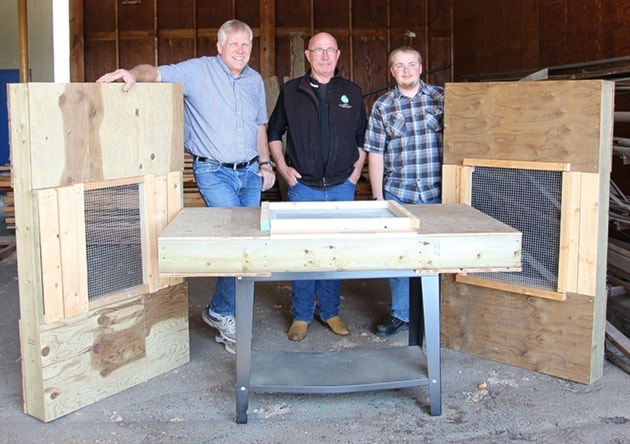Free prime real estate are available for Vanderhoof’s quacking residents to move into now, thanks to student carpenters.
Built by Vanderhoof’s woodworking students this year, floating docks for wild ducks to nest away from land predators are added to the wetlands of Redmond Flats conservation property on Quail Road east of Vanderhoof this June.
Though it’s the first time for Nechako Valley Secondary’s students to be involved in duck housing, others in the past built a series of bird houses that were installed in various locations in Vanderhoof to promote the avian population, said temporary woodworking teacher Carl Larsen.
“It’s about how to build one product and mimic that same product, learning about production line building,” Larsen said. “Like in the house building trade, you build the same wall again and again.”
It’s also an opportunity for students to learn problem solving, as they tried to use as much scrap wood as possible. “We think the ducks wouldn’t understand high quality versus medium quality wood,” he added.
Construction, proposed by Larsen, was the focus for this year’s senior woodworking class; students in the last several years mainly learned cabinetry. Other projects for the three students included a pump house for the Carrier Sekani Tribal Council, as well as house components such as rafters and walls on a model scale.
“I think there’s more to wood shop than cabinetry,” Larsen said.
New wetland park to come
The nesting docks are the latest addition to Redmond Flats in order to promote its wetland habitat potential, along with an osprey nest platform and grazing cows for vegetation control, said Wayne Salewski from Vanderhoof Fish and Game Club.
This spring, the club, along with Ducks Unlimited Canada and the District of Vanderhoof, signed a memorandum of understanding to develop the property as a public park for recreation trails and education on habitat conservation.
On the former farmland, cow-trimmed grass near water has shown to be a preferred site for some nesting ducks, while others prefer setting up house on the water, Salewski explained.
The landlocked water used to be part of Stoney Creek, before the stream changed course in recent years. Logs are also added to the wetland to create structure and habitat for amphibians.
